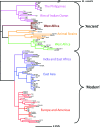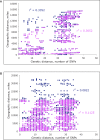High functional diversity in Mycobacterium tuberculosis driven by genetic drift and human demography
- PMID: 19090620
- PMCID: PMC2602723
- DOI: 10.1371/journal.pbio.0060311
High functional diversity in Mycobacterium tuberculosis driven by genetic drift and human demography
Abstract
Mycobacterium tuberculosis infects one third of the human world population and kills someone every 15 seconds. For more than a century, scientists and clinicians have been distinguishing between the human- and animal-adapted members of the M. tuberculosis complex (MTBC). However, all human-adapted strains of MTBC have traditionally been considered to be essentially identical. We surveyed sequence diversity within a global collection of strains belonging to MTBC using seven megabase pairs of DNA sequence data. We show that the members of MTBC affecting humans are more genetically diverse than generally assumed, and that this diversity can be linked to human demographic and migratory events. We further demonstrate that these organisms are under extremely reduced purifying selection and that, as a result of increased genetic drift, much of this genetic diversity is likely to have functional consequences. Our findings suggest that the current increases in human population, urbanization, and global travel, combined with the population genetic characteristics of M. tuberculosis described here, could contribute to the emergence and spread of drug-resistant tuberculosis.
Conflict of interest statement
Figures





Similar articles
-
Diversified lineages and drug-resistance profiles of clinical isolates of Mycobacterium tuberculosis complex in Malaysia.Int J Mycobacteriol. 2019 Oct-Dec;8(4):320-328. doi: 10.4103/ijmy.ijmy_144_19. Int J Mycobacteriol. 2019. PMID: 31793500
-
A Comprehensive Map of Mycobacterium tuberculosis Complex Regions of Difference.mSphere. 2021 Aug 25;6(4):e0053521. doi: 10.1128/mSphere.00535-21. Epub 2021 Jul 21. mSphere. 2021. PMID: 34287002 Free PMC article.
-
Genetic Diversity of Multi- and Extensively Drug-Resistant Mycobacterium tuberculosis Isolates in the Capital of Iran, Revealed by Whole-Genome Sequencing.J Clin Microbiol. 2019 Jan 2;57(1):e01477-18. doi: 10.1128/JCM.01477-18. Print 2019 Jan. J Clin Microbiol. 2019. PMID: 30404943 Free PMC article.
-
Host-pathogen coevolution in human tuberculosis.Philos Trans R Soc Lond B Biol Sci. 2012 Mar 19;367(1590):850-9. doi: 10.1098/rstb.2011.0316. Philos Trans R Soc Lond B Biol Sci. 2012. PMID: 22312052 Free PMC article. Review.
-
Single nucleotide polymorphisms in Mycobacterium tuberculosis and the need for a curated database.Tuberculosis (Edinb). 2013 Jan;93(1):30-9. doi: 10.1016/j.tube.2012.11.002. Epub 2012 Dec 21. Tuberculosis (Edinb). 2013. PMID: 23266261 Free PMC article. Review.
Cited by
-
Investigation of the high rates of extrapulmonary tuberculosis in Ethiopia reveals no single driving factor and minimal evidence for zoonotic transmission of Mycobacterium bovis infection.BMC Infect Dis. 2015 Mar 3;15:112. doi: 10.1186/s12879-015-0846-7. BMC Infect Dis. 2015. PMID: 25886866 Free PMC article.
-
Evolution and emergence of Mycobacterium tuberculosis.FEMS Microbiol Rev. 2024 Mar 1;48(2):fuae006. doi: 10.1093/femsre/fuae006. FEMS Microbiol Rev. 2024. PMID: 38365982 Free PMC article. Review.
-
Assessment of the genetic diversity of Mycobacterium tuberculosis esxA, esxH, and fbpB genes among clinical isolates and its implication for the future immunization by new tuberculosis subunit vaccines Ag85B-ESAT-6 and Ag85B-TB10.4.J Biomed Biotechnol. 2010;2010:208371. doi: 10.1155/2010/208371. Epub 2010 Jun 21. J Biomed Biotechnol. 2010. PMID: 20617139 Free PMC article.
-
Distinct genotypic profiles of the two major clades of Mycobacterium africanum.BMC Infect Dis. 2010 Mar 29;10:80. doi: 10.1186/1471-2334-10-80. BMC Infect Dis. 2010. PMID: 20350321 Free PMC article.
-
The consequences of genetic drift for bacterial genome complexity.Genome Res. 2009 Aug;19(8):1450-4. doi: 10.1101/gr.091785.109. Epub 2009 Jun 5. Genome Res. 2009. PMID: 19502381 Free PMC article.
References
-
- Raviglione MC, Smith IM. XDR tuberculosis–implications for global public health. N Engl J Med. 2007;356:656–659. - PubMed
-
- Gagneux S, Small PM. Molecular evolution of mycobacteria. In: Kaufmann SH, Rubin E, editors. Handbook of tuberculosis. Weinheim: Wiley VCH; 2008.
Publication types
MeSH terms
Grants and funding
LinkOut - more resources
Full Text Sources

